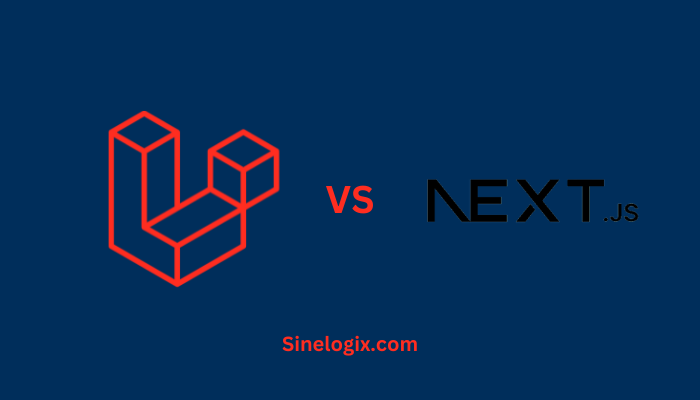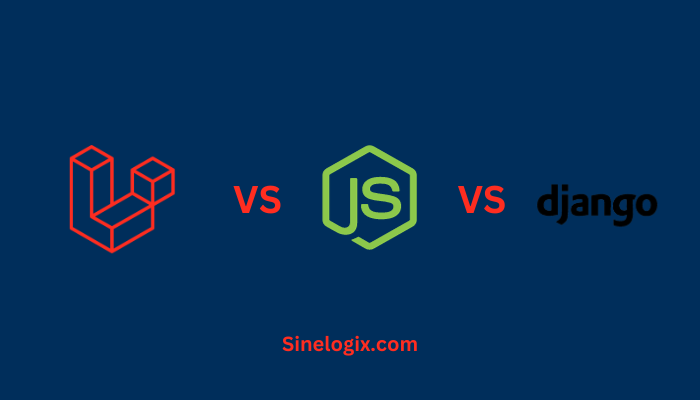Selecting the right framework for web development is pivotal, influencing your project’s success. In this comprehensive analysis, we explore the strengths of two prominent frameworks: Laravel and Next.js. Across 20 critical aspects, we provide nuanced insights to empower your decision-making process.
Introduction
The realm of web development presents an array of frameworks, each designed to cater to specific needs. Laravel, a robust PHP framework, and Next.js, a React-based framework, stand out as formidable choices. In this detailed comparison, we delve into their architectures, languages, security features, performance, and more to guide you in choosing the framework that aligns best with your project requirements.
1. Architecture
Laravel: Embracing the MVC (Model-View-Controller) architecture, Laravel provides a structured approach to application development. This separation enhances code organization and maintainability. Laravel’s architectural design is well-suited for projects of varying complexities, offering a clean and scalable foundation.
Next.js: A React-based framework, Next.js, follows a component-driven architecture. It introduces the concept of pages, allowing developers to create dynamic web applications by combining components. Next.js provides a flexible and modular structure, making it particularly favorable for modern, client-side rendered applications.
2. Language
Laravel: Written in PHP, Laravel leverages the versatility of this widely-used scripting language. PHP’s broad adoption and continuous improvement make Laravel a reliable choice for web development. Laravel harnesses PHP’s features to offer an expressive syntax, facilitating rapid and efficient development.
Next.js: Primarily using JavaScript, Next.js extends the capabilities of React by adding server-side rendering and other features. With the increasing popularity of TypeScript, Next.js also supports this superset of JavaScript, offering developers static typing for enhanced code quality.
3. Security
Laravel: Renowned for its robust security features, Laravel incorporates built-in functionalities like CSRF protection, encryption, and a dedicated security team. Laravel’s commitment to security reduces the risk of common web vulnerabilities, ensuring a secure development environment.
Next.js: As a front-end framework, Next.js relies on the security practices of React and the underlying Node.js server. Developers need to adhere to best practices and stay updated on potential security risks in the JavaScript ecosystem.
4. Performance
Laravel: Optimized for performance, Laravel employs opcode caching and Laravel Mix for efficient asset compilation. These optimizations contribute to faster response times and improved overall performance, making Laravel suitable for a range of applications.
Next.js: With its focus on server-side rendering (SSR) and static site generation (SSG), Next.js aims for optimal performance. The framework’s approach to rendering allows for faster page loads and improved user experiences, especially in content-heavy applications.
5. Community and Ecosystem
Laravel: Boasting a large and active community, Laravel benefits from a vast ecosystem of packages and plugins. The community support ensures continuous improvement, extensive documentation, and a wealth of resources for developers. Laravel’s ecosystem provides solutions for a wide range of functionalities, simplifying development tasks.
Next.js: As part of the React ecosystem, Next.js taps into the extensive resources and community support surrounding React. The React community’s collaboration extends to Next.js, fostering a rich ecosystem of plugins and modules that enhance the framework’s capabilities.
6. Database Support
Laravel: Laravel’s Eloquent ORM supports multiple databases, including MySQL, PostgreSQL, and SQLite. This flexibility allows developers to choose the database that best suits their project needs. Eloquent’s intuitive syntax and powerful features make database interactions seamless and enjoyable for developers.
Next.js: Being primarily a front-end framework, Next.js doesn’t dictate specific database choices. The choice of database depends on the backend technology used in conjunction with Next.js, making it adaptable to a variety of database systems.
7. REST API Development
Laravel: Renowned for exceptional support for building RESTful APIs, Laravel provides built-in features and additional packages that simplify the development process. Laravel’s dedicated API tools, such as resource controllers and Eloquent resources, streamline API development, making it an ideal choice for projects with strong API requirements.
Next.js: While Next.js is not specifically designed for REST API development, it can be used to create APIs when combined with serverless functions or an appropriate backend technology. However, for REST APIs, Laravel’s native support and tools provide a more streamlined development experience.
8. GraphQL Support
Laravel: While Laravel supports GraphQL through additional packages, integrating GraphQL functionalities may require additional configuration. The ecosystem provides flexibility but demands extra effort for implementation. Laravel developers can leverage packages like Lighthouse to implement GraphQL seamlessly.
Next.js: Integrating seamlessly with GraphQL, Next.js simplifies the development of GraphQL-based APIs. The framework’s structure and flexibility make it well-suited for projects leveraging GraphQL to query and manipulate data.
9. Real-Time Features
Laravel: Implementing real-time features in Laravel involves tools like Laravel Echo and Pusher, facilitating the integration of WebSockets and enabling dynamic, real-time user experiences. Laravel Echo provides an elegant API for handling WebSockets, making it easy for developers to implement real-time features without extensive configuration.
Next.js: While Next.js is primarily focused on rendering React components, real-time features can be implemented using additional libraries or tools such as Socket.io. However, Next.js may not be the optimal choice for applications requiring extensive real-time functionality.
10. Testing
Laravel: Comes equipped with PHPUnit, a robust testing framework that fosters a comprehensive testing environment. Laravel’s testing tools allow developers to write unit tests, feature tests, and even browser tests effortlessly. PHPUnit’s integration with Laravel’s testing suite ensures reliable and efficient testing processes.
Next.js: As a front-end framework, Next.js encourages testing of React components using tools like Jest and React Testing Library. While Next.js itself does not include a testing framework, developers can seamlessly integrate these tools for thorough testing of their applications.
11. Scalability
Laravel: While scalable, applications with high-traffic demands may require additional configurations. Laravel’s scalability shines in medium to large-sized projects with moderate traffic. Laravel Horizon, a robust job queue monitoring tool, enhances scalability by efficiently handling tasks in the background.
Next.js: Designed to scale, Next.js benefits from server-side rendering and static site generation, enabling fast and efficient content delivery. As traffic grows, Next.js applications can be optimized for scalability by leveraging its built-in features and choosing appropriate hosting solutions.
12. Documentation
Laravel: Offers comprehensive documentation, providing developers with clear guidance and examples for effective implementation. Laravel’s documentation covers everything from installation to advanced features, making it a valuable resource for both beginners and experienced developers.
Next.js: Maintaining high-quality documentation, Next.js provides detailed guides, examples, and API references. The documentation is structured to cater to developers of varying skill levels, aiding in the efficient implementation of Next.js features and best practices.
13. Middleware
Laravel: Implementing middleware in Laravel allows developers to handle HTTP requests at various stages, providing a centralized mechanism for request processing. Laravel’s middleware system allows developers to inject custom logic before or after the request is handled, enhancing flexibility and customization.
Next.js: Primarily designed for front-end development, Next.js doesn’t include a middleware system like Laravel. Middleware functionality for backend processes would depend on the chosen backend technology used in conjunction with Next.js.
14. Code Organization
Laravel: Following a convention-over-configuration paradigm, Laravel simplifies code organization and ensures consistency across projects. Laravel’s folder structure and naming conventions encourage developers to organize code in a way that aligns with best practices, streamlining collaboration and onboarding.
Next.js: Promoting a modular structure, Next.js facilitates code organization, especially in larger projects. The framework’s emphasis on components and pages encourages the creation of reusable elements, contributing to code maintainability. Developers familiar with React will find Next.js’s code organization intuitive.
15. Authentication
Laravel: Laravel simplifies authentication with built-in features such as Laravel Passport, streamlining the process of implementing secure authentication mechanisms. Laravel Passport provides a full OAuth2 server implementation with minimal configuration, making it easy for developers to integrate secure authentication into their applications.
Next.js: Primarily a front-end framework, Next.js doesn’t handle backend processes, including authentication. Authentication would depend on the chosen backend technology used in conjunction with Next.js.
16. Dependency Injection
Laravel: Laravel employs a powerful Inversion of Control (IoC) container for managing class dependencies, enhancing code maintainability. The IoC container allows developers to inject dependencies into classes rather than hard-coding them, promoting loose coupling and making code more modular and testable.
Next.js: As a front-end framework, Next.js doesn’t emphasize server-side dependency injection. Dependencies in Next.js are typically managed through npm packages and React components, following best practices for front-end development.
17. Learning Curve
Laravel: Known for its beginner-friendly nature, Laravel features straightforward syntax and extensive documentation, reducing the learning curve. Laravel’s documentation includes guides, tutorials, and examples that cater to developers of all skill levels. The framework’s simplicity and expressive syntax make it an ideal choice for those new to web development.
Next.js: While React, and by extension Next.js, is beginner-friendly, there may be a learning curve for those new to JavaScript and front-end development concepts. Developers with prior experience in React will find Next.js more accessible, and its documentation serves as a valuable resource for learning the framework.
18. Community Support
Laravel: Enjoying strong community support, Laravel features forums, conferences, and a vibrant ecosystem. The community actively contributes to the framework’s improvement, addresses issues, and shares best practices. Laravel’s popularity ensures a robust and engaged community that provides valuable resources for developers.
Next.js: Part of the broader React community, Next.js benefits from the widespread adoption of React. The React community’s support extends to Next.js, providing a collaborative environment for developers. The popularity of React and Next.js ensures a growing community with diverse expertise.
19. Tooling
Laravel: Laravel’s artisan command-line tools streamline various tasks, enhancing developer productivity with efficient workflows. The artisan CLI provides commands for tasks such as database migrations, testing, and code generation, reducing the manual effort required for routine development tasks.
Next.js: Equipped with a powerful Command Line Interface (CLI), Next.js provides tools for scaffolding, testing, and running applications. The CLI includes commands for creating pages, managing dependencies, and optimizing production builds, enhancing efficiency in the development process.
20. Popularity
Laravel: Embraced widely in the PHP community, Laravel boasts a significant number of projects and companies adopting it for diverse applications. Laravel’s popularity is evident in its extensive usage, community engagement, and the numerous successful projects built with the framework.
Next.js: Gaining popularity in the React and JavaScript ecosystem, Next.js indicates a growing user base. The framework’s popularity is a testament to its capabilities and appeal within the development community. As more developers adopt Next.js, its ecosystem and community support are expected to grow further.
Related Articles:
Conclusion
In this comprehensive exploration of Laravel and Next.js, both frameworks showcase unique strengths. Laravel, deeply rooted in PHP, offers simplicity and a rich feature set, making it an excellent choice for a variety of projects. Next.js, built on React, provides a modern and flexible front-end solution, especially for applications requiring dynamic user interfaces and server-side rendering.
To make an informed decision, carefully evaluate your project’s specific needs, team expertise, and long-term objectives. Whether you opt for the robustness of Laravel or the flexibility of Next.js, each framework holds the potential to elevate your web development endeavors.
By understanding the intricacies of these frameworks, you gain not only a deeper comprehension of their capabilities but also the insight needed to align your choice with the unique requirements of your project. As the web development landscape continues to evolve, the knowledge gained from this comprehensive comparison ensures that you are well-equipped to navigate the complexities of modern web development.




